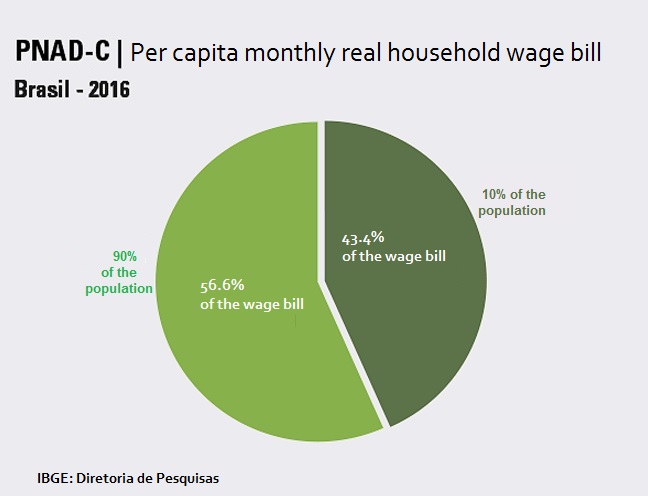Income inequality: seen in different Major Regions, sexes, colors and levels of schooling
November 29, 2017 10h00 AM | Last Updated: November 29, 2017 04h26 PM
In 2016, persons among the top 1% income earners made, on the average, R$ 27,085, whereas the 50% lower owners R$ 747, in a country where the average monthly income from work amounted to R$ 2,149. In that same year, the 10% top incomer earners concentrated 43.4% of the income sources in Brazil.
Thee figures, that reveal income inequality and concentration in the country, are part of the module "Income from all sources" of the 2016 National Household Sample Survey, released today by the IBGE.

The Southeast, with R$ 132.7 billion, had the biggest share of the total income, surpassing the contributions of all the other Major Regions, together: Northeast (R$ 43.8 billion), South (R$ 43.5 billion), Central West (R$ 21.8 billion) and North (R$ 13.5 billion). According to Cimar Azeredo, head of the Department of Labor and Income, “disparity results, basically, from the concentration of persons in that Major Region, which is equivalent to the concentration of persons in this region, 42% of the total”.
The northeastern population presents the smallest difference (8.1 percentage points) among all incomes from work (35.7%) and from other sources (27.6%). Cimar highlights that the smallest the difference between the income sources, the less developed the locality: “It a Major Region with more informality in work, which contributes to higher unemployment rates. These unfavorable characteristics cause the population to depend on income transfer programs.”
Women earn 22.9% less than men
Although women represent more than half of the working-age population, men had 57.5% of the job posts. Women earned, on the average, R$ 1,836, 22.9% less than men (R$ 2,380). The Southeast had the highest average income for men (R$ 2,897) and women (R$ 2,078), but more inequality, with women earning 28.3% less than men.
In the analysis by color or race, the average income from all the activities of white persons (R$ 2,810) was approximately 45% bigger than that of black persons (R$ 1,547) and brown ones (R$ 1,524). The income of white persons was 30.8% above the national average (R$ 2,149), whereas blacks and browns earned, respectively, 28.0% and 29.1% less.
In terms of level of schooling of the employed population, workers with a higher education degree had a monthly income of R$ 5,189, about three times that of persons with a high school degree (R$ 1,716), and about six times above that of persons with no schooling (R$ 884).
Text (in Portuguese): Pedro Renaux
Design: J.C. Rodrigues
Image: Pixabay




















